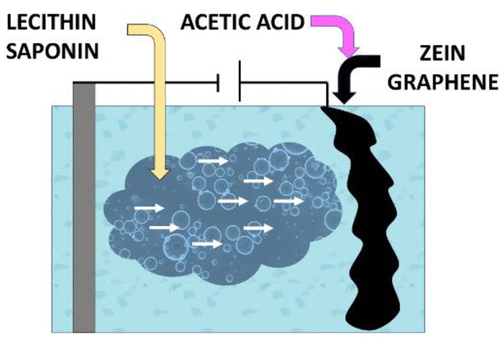Our official English website, www.x-mol.net, welcomes your
feedback! (Note: you will need to create a separate account there.)
Zein-Bonded Graphene and Biosurfactants Enable the Electrokinetic Clean-Up of Hydrocarbons
Langmuir ( IF 3.7 ) Pub Date : 2021-09-12 , DOI: 10.1021/acs.langmuir.1c02018 Laura Earnden 1 , Alejandro G Marangoni 2 , Stefano Gregori 1 , Athanasios Paschos 3, 4 , Erica Pensini 1
Langmuir ( IF 3.7 ) Pub Date : 2021-09-12 , DOI: 10.1021/acs.langmuir.1c02018 Laura Earnden 1 , Alejandro G Marangoni 2 , Stefano Gregori 1 , Athanasios Paschos 3, 4 , Erica Pensini 1
Affiliation

|
Nonaqueous phase liquids (NAPL, e.g., hydrocarbons and chlorinated compounds) are common groundwater pollutants. Electrokinetic remediation of NAPLs uses electric fields to draw them toward electrodes and remove them from groundwater. The treatment requires NAPL mobility. Emulsification increases mobility, but at a risk for downstream receptors. We propose using alkaline aqueous solutions of zein and graphene nanoparticles (GNP) to form conductive materials, which could also act as barriers to control NAPL migration. Alkaline zein–GNP solutions can be injected in the polluted soil and solidified by neutralizing the pH (e.g., with glacial acetic acid, GAA). Shear rheology experiments showed that zein–GNP composites were cohesive, and voltammetry showed that GNP increased electrical conductivity of zein-based materials by 3.5 times. Gas chromatography–mass spectroscopy (GC–MS) demonstrated that the electrokinetic treatment of model sandy aquifers yielded >60% and ∼47% removal of emulsified toluene in freshwater and in salt solutions, respectively (with 30 min treatment using a 10 V differential voltage between a zein–GNP and an aluminum electrode. NaCl was used as model salt contaminant. The conductivity of surfactant solutions was lower in saline water than in freshwater, explaining differences in toluene removal. Toluene–water emulsions were stabilized using the natural surfactants lecithin and saponin. These surfactants acted synergistically in stabilizing emulsions in either freshwater or salt solutions. Lecithin and saponin likely interacted at toluene–water interfaces, as indicated by the morphology, interfacial tension and compressional rigidity of toluene–water interfaces with both components (relative to interfaces of either lecithin or saponin alone). The compressional behavior of interfacial films was well-described by the Marczak model. Electrokinetic treatment of saturated model sandy aquifers also decreased the turbidity of emulsions of water and either tricholoroethylene (TCE, by ∼41%) or diesel (by ∼75%), in the presence of a bacterial biosurfactant. This decrease was used as semiquantitative indicator of NAPL removal from water.
中文翻译:

玉米蛋白键合石墨烯和生物表面活性剂可实现碳氢化合物的电动清理
非水相液体(NAPL,例如碳氢化合物和氯化化合物)是常见的地下水污染物。NAPL 的电动修复使用电场将它们拉向电极并将它们从地下水中去除。治疗需要 NAPL 流动性。乳化增加了流动性,但对下游受体有风险。我们建议使用玉米蛋白和石墨烯纳米粒子 (GNP) 的碱性水溶液来形成导电材料,这也可以作为控制 NAPL 迁移的屏障。碱性玉米醇溶蛋白-GNP 溶液可以注入被污染的土壤中,并通过中和 pH 值(例如,用冰醋酸,GAA)固化。剪切流变实验表明玉米醇溶蛋白-GNP 复合材料具有内聚性,伏安法表明 GNP 将玉米醇溶蛋白基材料的电导率提高了 3.5 倍。甲苯-水界面与两种组分的界面张力和压缩刚度(相对于单独的卵磷脂或皂苷的界面)。Marczak 模型很好地描述了界面膜的压缩行为。在存在细菌生物表面活性剂的情况下,对饱和模型砂质含水层进行电动处理还降低了水和三氯乙烯(TCE,降低约 41%)或柴油(降低约 75%)的乳状液的浊度。这种减少被用作从水中去除 NAPL 的半定量指标。在存在细菌生物表面活性剂的情况下,对饱和模型砂质含水层进行电动处理还降低了水和三氯乙烯(TCE,降低约 41%)或柴油(降低约 75%)的乳状液的浊度。这种减少被用作从水中去除 NAPL 的半定量指标。在存在细菌生物表面活性剂的情况下,对饱和模型砂质含水层进行电动处理还降低了水和三氯乙烯(TCE,降低约 41%)或柴油(降低约 75%)的乳状液的浊度。这种减少被用作从水中去除 NAPL 的半定量指标。
更新日期:2021-09-21
中文翻译:

玉米蛋白键合石墨烯和生物表面活性剂可实现碳氢化合物的电动清理
非水相液体(NAPL,例如碳氢化合物和氯化化合物)是常见的地下水污染物。NAPL 的电动修复使用电场将它们拉向电极并将它们从地下水中去除。治疗需要 NAPL 流动性。乳化增加了流动性,但对下游受体有风险。我们建议使用玉米蛋白和石墨烯纳米粒子 (GNP) 的碱性水溶液来形成导电材料,这也可以作为控制 NAPL 迁移的屏障。碱性玉米醇溶蛋白-GNP 溶液可以注入被污染的土壤中,并通过中和 pH 值(例如,用冰醋酸,GAA)固化。剪切流变实验表明玉米醇溶蛋白-GNP 复合材料具有内聚性,伏安法表明 GNP 将玉米醇溶蛋白基材料的电导率提高了 3.5 倍。甲苯-水界面与两种组分的界面张力和压缩刚度(相对于单独的卵磷脂或皂苷的界面)。Marczak 模型很好地描述了界面膜的压缩行为。在存在细菌生物表面活性剂的情况下,对饱和模型砂质含水层进行电动处理还降低了水和三氯乙烯(TCE,降低约 41%)或柴油(降低约 75%)的乳状液的浊度。这种减少被用作从水中去除 NAPL 的半定量指标。在存在细菌生物表面活性剂的情况下,对饱和模型砂质含水层进行电动处理还降低了水和三氯乙烯(TCE,降低约 41%)或柴油(降低约 75%)的乳状液的浊度。这种减少被用作从水中去除 NAPL 的半定量指标。在存在细菌生物表面活性剂的情况下,对饱和模型砂质含水层进行电动处理还降低了水和三氯乙烯(TCE,降低约 41%)或柴油(降低约 75%)的乳状液的浊度。这种减少被用作从水中去除 NAPL 的半定量指标。











































 京公网安备 11010802027423号
京公网安备 11010802027423号